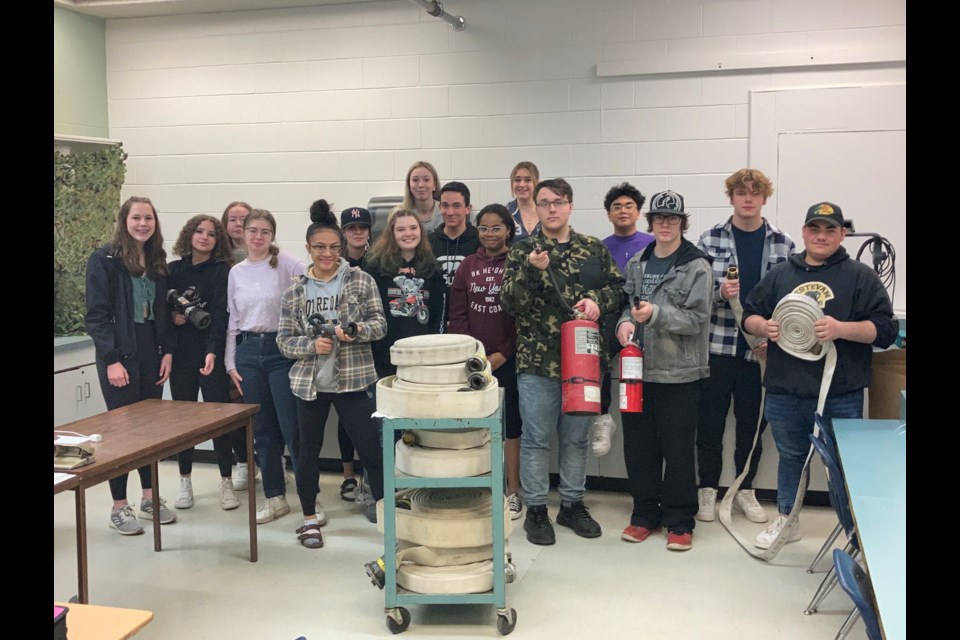ESTEVAN - For the past two years, the Estevan Comprehensive School has been educating students about what it takes to choose a career in policing, EMS, firefighting, or search and rescue.
However, only now were they able to start engaging the participating class through in-person workshops and training, which explain the basics better than any words.
The Emergency Services Response Training class is offered to 22 Grade 10 students at ECS, and now, after two years of delays caused by the pandemic, it incorporates a hands-on approach and engagement with the local first responders.
Teacher Stephen Froese took over the class this year and said so far, their experiences were very interesting and useful.
"It's a locally developed course. Weyburn started it. And it's a course made around fire services, police services, ambulance service, the EMS, and search and rescue. So the course was designed for those four pieces. And they had such good luck in Weyburn with students wanting to take this, that we started the class here in Estevan," Froese explained.
Not only does the curriculum assume students learn a lot about the potential career paths in emergency services, but they also dig into the theory behind the jobs and history. Besides, the curriculum expects students acquire and demonstrate various relevant skills in the four fields.
"It's a nice mix of theory and practical application," Froese said.
Lately, the students were working on the firefighting unit.
"We got in touch with the fire chief, then he came and visited us here and then we went there, and he was more than happy to walk us through steps on how to fight a fire," Froese said.
Students paid a visit to the Estevan fire department to learn about fire extinguishers and much more at the end of March. During their time at the school, the fire chief touched on what the fire and rescue services are about, how firefighters orientate construction design and the types of emergencies that they respond to. They also went into the types of apparatus that Estevan uses, different response levels and call volumes.
Later students paid a visit to the fire station for a tour and to see the apparatus and some of the protective equipment in real life. Then they had a chance to go through an actual fire extinguisher training class, followed by a practical skills component where they were able to use the fire extinguisher – a real-life skill that might be useful later on. They also got to try putting on the firefighter's gear in under 90 seconds – another real-life element of the job.
"They were very, very attentive going through the class. They were asking lots of valid questions. It was really nice," said Estevan Fire Chief Dale Feser.
Students also had a chance to learn from the Estevan RCMP, which came in to do a careers presentation earlier this year. Estevan Police Service members also visited the class to talk about what it's like to become a police officer and what a day in this job looks like. Later the EPS also brought in their canine unit and went over some of the specifics of working with a service dog.
"This was the first time for the canine. They answered all the questions on what it's like to be a canine unit. And then they actually brought in some drugs, and we put them in the class. And then the dog came in and we got to watch the dog do his job," Froese said.
"We are trying to make it a class that they can learn something in real life and maybe want to go into that career," he added.
Froese also has a Canada Border Services Agency presentation arranged, and the EPS canine is scheduled to be back to showcase some other components of the job. Then the EPS investigation unit will teach about fingerprints analysis.
The teacher is also currently working on arranging activities with the Estevan EMS as well as with Â鶹´«Ã½AV East Saskatchewan Search and Rescue. They also have a virtual tour of the Northwest Mounted Police Museum slated for May.
"We are trying to get as many people into the class as we can. It's not the easiest for us to travel to the places," Froese said. "But we want [students] to do as much hands-on as we can offer them."
At the end of the one-semester course, students will also go through first aid training and certification.
"Not too many classes can get you certifications that you need in real life. This course is designed to prepare students for those things. Some jobs require you to have first aid, and the students can get that here," Froese said.
Feser said the experience students had is a small part of the tip of the iceberg, but it does give them an idea of what kind of skills and classes they'd need in high school, if they choose to become a firefighter, for example.
Froese added that the attendance for this class is really good, which is a reasonable way to evaluate the class.
"Usually, the attendance is almost perfect. For other courses that I've taught, usually, five to 10 per cent of the class is out at one time. But now I have almost full attendance every class and I think it's because it's that interesting," Froese said.





